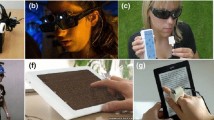Abstract
Benefiting from today’s global positioning systems (GPS) and geographic information systems (GIS), visually impaired individuals are able to travel more independently than before. However, due to a lack of accessibility information about geographic features, those navigation systems fail to satisfy their special requirements. To help visually impaired people access and share environmental accessibility information in cities ubiquitously, this paper presents a collaborative and cross-device hypermedia system, namely GeoCoach. In addition to desktop computers, visually impaired people are able to access environmental accessibility on a pin-arrayed display and on mobile phones. The two user studies conducted with visually impaired users indicate that the proposed system was effective.
Similar content being viewed by others
References
Azenkot S, Prasain S, Borning A, Fortuna E, Ladner R, Wobbrock J (2011) Enhancing Independence and Safety for Blind and Deaf-Blind Public Transit Riders. In: Proc. ACM CHI ’11, pp 3247–3256
Bigham JP, Kaminsky RS, Ladner RE, Danielsson OM, Hempton GL (2006) WebInSight: Making Web Images Accessible. In: Proc. ASSETS’06. ACM Press, Portland, OR, USA, pp 181–188
Bigham JP, Jayant C, Ji H, Little G, Miller A, Miller RC, Miller R, Tatarowicz A, White B, White S, Yeh T (2010) VizWiz: Nearly Real-Time Answers to Visual Questions. In: Proc. UIST’10. ACM Press, New York, USA, pp 333–342
Brady E, Bigham JP (2014) Crowdsourcing accessibility: Human-powered access technologies. Found Trends Hum Comput Interact 8(4):273–372
Brock AM, Truillet P, Oriola B, Picard D, and Jouffrais C (2015) Interactivity improves usability of geographic maps for visually impaired people. Hum Comput Interact 30(2):156–194
Fallah N, Apostolopoulos I, Bekris K, Folmer E (2012) The User As a Sensor: Navigating Users With Visual Impairments in Indoor Spaces Using Tactile Landmarks. In: Proc. ACM CHI 2012. ACM Press, Austin, pp 425–432
Golledge RG (1993) Geography and the disabled: A survey with special reference to vision impaired and blind populations. T I Brit Geogr 18(1):63–85
Goodchild MF (2007) Citizens as sensors: The world of volunteered geography. GeoJournal 69:211–221
Haklay M, Weber P (2008) OpenStreetMap: User-generated street maps. IEEE Pervasive Comput 7(4):12–18
Hara K, Azenkot S, Campbell M, Bennett C, Le V, Pannella S, Moore R, Minckler K, Ng RH, Froehlich JE (2013) Improving Public Transit Accessibility for Blind Riders by Crowdsourcing Bus Stop Landmark Locations With Google Street View. In: Proc ACM ASSETS ’13. ACM, New York
Holone H, Misund G, Tolsby H, Kristoffersen S (2008) Aspects of Personal Navigation with Collaborative User Feedback. In: Proc. Nordic Conference on Human-Computer Interaction 2008, pp 182–191
Kaklanis N, Votis K, Tzovaras D (2013) Open touch/sound maps: A system to convey street data through haptic and auditory feedback. Comput Geosci 57:59–67
Kane SK, Morris MR, Perkins AZ, Wigdor D, Ladner RE, Wobbrock JO (2011) Access Overlays: Improving Nonvisual Access to Large Touch Screens for Blind Users. In: Proc. ACM UIST 2011, Santa Barbara, USA. ACM Press, New York, pp 273–282
Karimi HA, Dias B, Pearlman J, Zimmerman G (2014) Wayfinding and navigation for people with disabilities using social navigation networks. Trans Collab Comput 14(2):e5
Miele J, Landau S, Gilden D (2006) Talking TMAP: automated generation of audio-tactile maps using Smith-Kettlewell’s TMAP software. Br J Visual Impair 24:93–100
Mirri S, Prandi C, Salomoni, P., Callegati, F. and Campi, A. (2014) On Combining Crowdsourcing, Sensing and Open Data for an Accessible Smart City. In: Proceedings of the 3rdInternational Conference on Technologies and Applications for Smart Cities (I-TASC’14)
Moustakas K, Nikolakis G, Kostopoulos K, Tzovaras D, Strintzis MG (2007) Haptic rendering of visual data for the visually impaired. IEEE Multimedia 14:62–72
Takagi H, Kawanaka S, Kobayashi M, Itoh T, Asakawa C (2008) Social Accessibility: Achieving Accessibility Through Collaborative Metadata Authoring. In: Proc. ASSETS’08. ACM Press, Halifax, Nova Scotia, Canada, pp 193–200
Völkel T, Weber G (2008) RouteCheckr: Personalized Multicriteria Routing for Mobility Impaired Pedestrians. In: Proc. ASSETS’08. ACM Press, Halifax, Nova Scotia, Canada, pp 185–192
Wang Z, Li N, Li B (2012) Fast and independent access to map directions for people who are blind. Interact Comput 24:91–106
Wiener WR, Welsh RL, Blasch BB (2010) Foundations of Orientation and Mobility, 3rd edn. American Foundation for the Blind press, New York, USA
Yang R, Park S, Mishra S, Hong Z, Newsom C, Joo H, Hofer E, Newman MW (2011) Supporting Spatial Awareness and Independent Wayfinding for Pedestrians with Visual Impairments. ACM ASSETS ’11. ACM, New York, pp 27–34
Zeng L (2015) A Survey: Outdoor Mobility Experiences by the Visually Impaired. In: Weisbecker A, Burmester M, Schmidt A (eds) Mensch und Computer 2015 – Workshopband. De Gruyter Oldenbourg, Berlin, pp 391–397
Zeng L, Kühn R, Weber G (2016) Improvement in environmental accessibility via volunteered geographic information: a case study. Univ Access Inf Soc, doi:https://doi.org/10.1007/s10209-016-0505-9
Zeng L, Miao M, Weber G (2015) Interactive audio-haptic explorers on a tactile display. Interact Comput 27(4):413–429
Zeng L, Weber G (2015) A Pilot Study of Collaborative Accessibility: How Blind People Find an Entrance. In: Proceedings of ACM MobilHCI 2015, pp 347–356
Zeng L, Weber G (2016) Exploration of location-aware You-Are-Here maps on a pin-matrix display. IEEE Trans Hum Mach Syst 46(1):88–100
Author information
Authors and Affiliations
Corresponding author
Rights and permissions
About this article
Cite this article
Zeng, L., Weber, G. GeoCoach: A cross-device hypermedia system to assist visually impaired people to gain environmental accessibility. Informatik Spektrum 40, 527–539 (2017). https://doi.org/10.1007/s00287-017-1071-0
Published:
Issue Date:
DOI: https://doi.org/10.1007/s00287-017-1071-0




